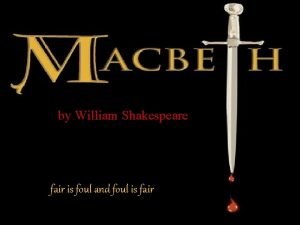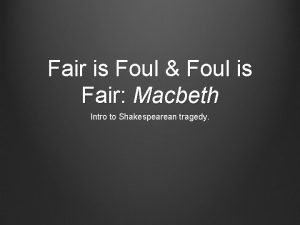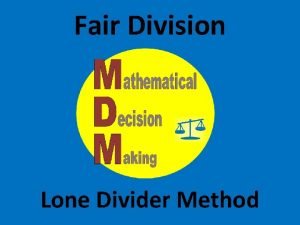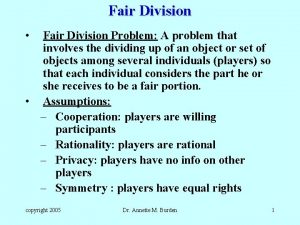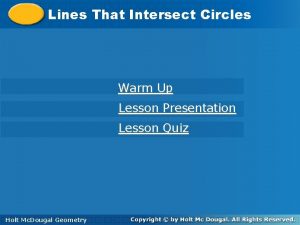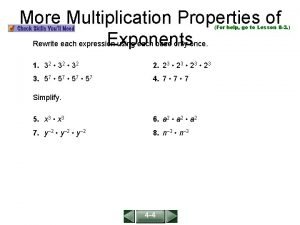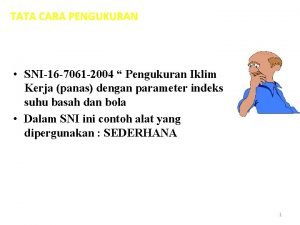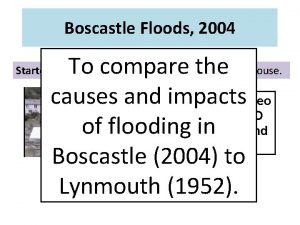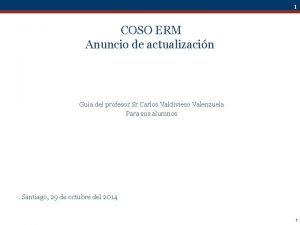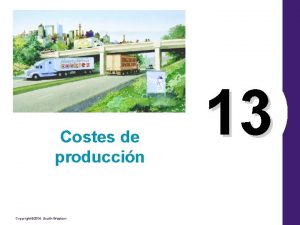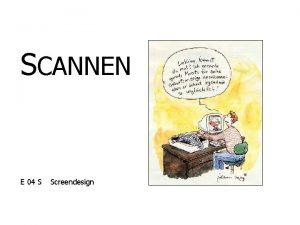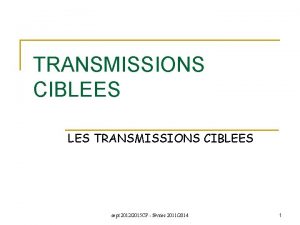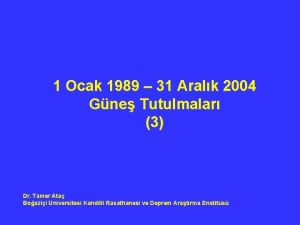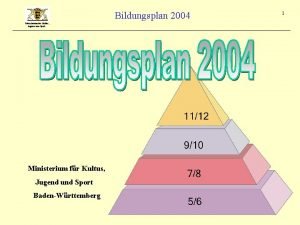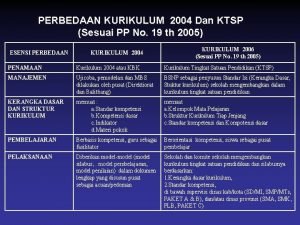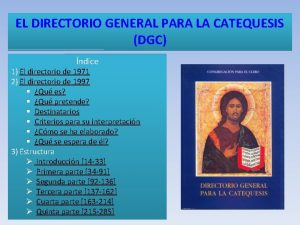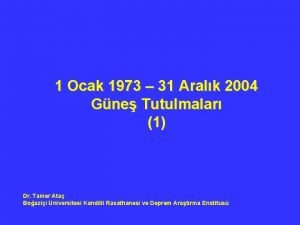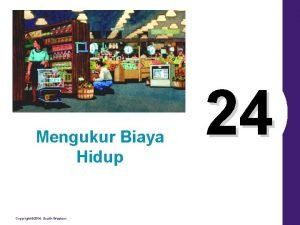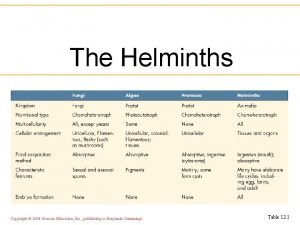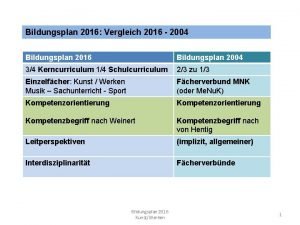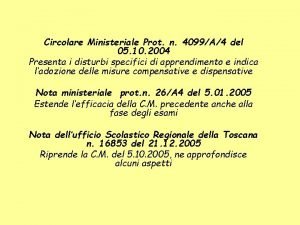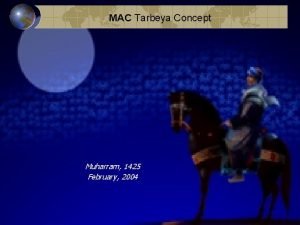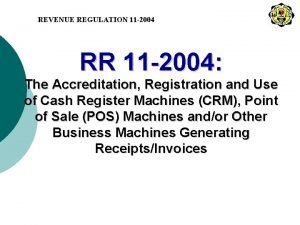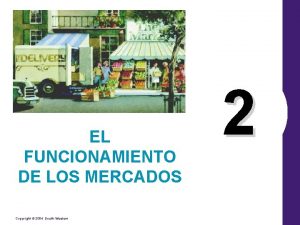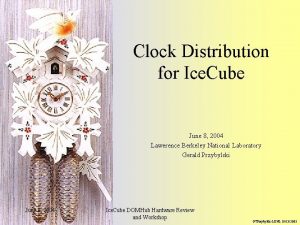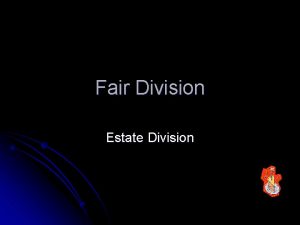Fair Division Mike Sumerton 2004 Estate Division Each
























































































- Slides: 88

Fair Division Mike Sumerton, 2004

Estate Division • Each participant determines a “fair share” and then gets that much or more. • Good for things that can not be divided up. • Not “envy free”.

Dividing up an Estate • Amanda, Pete, and Angel are heirs to an estate that includes a house, a boat, a car and $150, 000 in cash.

• Amanda, Pete, and Angel are heirs to an estate that includes a house, a boat, a car and $150, 000 in cash. • Each person makes a bid on each item (not including cash which is easy to split up). House Boat Car Amanda 80, 000 5, 000 8, 000 Pete 70, 000 9, 000 11, 000 76, 000 7, 000 13, 000 Angel

• Amanda thinks the value of the estate is 80, 000 + 5, 000 + 8, 000 + 150, 000= $243, 000. • Her fair share would be 243, 000/3 = $81, 000 • What would Pete think his fare share is? House Boat Car Amanda 80, 000 5, 000 8, 000 Pete 70, 000 9, 000 11, 000 76, 000 7, 000 13, 000 Angel Fair Share 81, 000 Aw

• Pete thinks the value of the estate is 70, 000 + 9, 000 + 11, 000 + 150, 000 = $240, 000. • His fair share would be 240, 000/3 = $80, 000. • What would Angel think her fare share is? House Boat Car Fair Share Amanda 80, 000 5, 000 81, 000 Pete 70, 000 9, 000 11, 000 80, 000 Angel 76, 000 7, 000 13, 000 Awards

• Angel thinks the value of the estate is 76, 000 + 7, 000 + 13, 000 + 150, 000 = $246, 000. • Her fair share would be 246, 000/3 = $82, 000. House Boat Car Fair Share Amanda 80, 000 5, 000 81, 000 Pete 70, 000 9, 000 11, 000 80, 000 Angel 76, 000 7, 000 13, 000 82, 000 Awards

Amanda, Pete, and Angel are heirs to an estate that includes a house, a boat, a car and $150, 000 in cash House Boat Car Amanda 80, 000 5, 000 8, 000 Pete 70, 000 9, 000 11, 000 Angel 76, 000 7, 000 13, 000 Who should get the house?

Amanda, Pete, and Angel are heirs to an estate that includes a house, a boat, a car and $150, 000 in cash House Boat Car Amanda 80, 000 5, 000 8, 000 Pete 70, 000 9, 000 11, 000 Angel 76, 000 7, 000 13, 000 Who should get the boat?

Amanda, Pete, and Angel are heirs to an estate that includes a house, a boat, a car and $150, 000 in cash House Boat Car Amanda 80, 000 5, 000 8, 000 Pete 70, 000 9, 000 11, 000 Angel 76, 000 7, 000 13, 000 Who should get the Car?

Amanda, Pete, and Angel are heirs to an estate that includes a house, a boat, a car and $150, 000 in cash. House Boat Car Amanda 80, 000 5, 000 8, 000 Pete 70, 000 9, 000 11, 000 Angel 76, 000 7, 000 13, 000

Amanda, Pete, and Angel are heirs to an estate that includes a house, a boat, a car and $150, 000 in cash. House Boat Car Fair Share Awards Amanda 80, 000 5, 000 81, 000 80, 000 Pete 70, 000 9, 000 11, 000 80, 000 9, 000 Angel 76, 000 7, 000 13, 000 82, 000 13, 000

Amanda, Pete, and Angel are heirs to an estate that includes a house, a boat, a car and $150, 000 in cash. House Boat Car Fair Share Award Cash dist Amanda 80, 000 5, 000 81, 000 80, 000 1, 000 Pete 70, 000 9, 000 11, 000 80, 000 9, 000 71, 000 Angel 76, 000 7, 000 13, 000 82, 000 13, 000 69, 000 • Award each person a share of the cash to reach their “Fair share”. • How much money is left?

Amanda, Pete, and Angel are heirs to an estate that includes a house, a boat, a car and $150, 000 in cash. House Boat Car Fair Share Award Cash dist Amanda 80, 000 5, 000 81, 000 80, 000 1, 000 Pete 70, 000 9, 000 11, 000 80, 000 9, 000 71, 000 Angel 76, 000 7, 000 13, 000 82, 000 13, 000 69, 000 • 1, 000 + 71, 000 + 69, 000 = $141, 000 • 150, 000 – 141, 000 = $9, 000 • 9, 000 / 3 = $3, 000

Amanda, Pete, and Angel are heirs to an estate that includes a house, a boat, a car and $150, 000 in cash. House Boat Car Fair Share Award Cash dist Amanda 80, 000 5, 000 81, 000 80, 000 1, 000 +3, 000 Pete 70, 000 9, 000 11, 000 80, 000 9, 000 71, 000 + 3, 000 Angel 76, 000 7, 000 13, 000 82, 000 13, 000 69, 000 + 3, 000 • Amanda gets the house, and $4000, which she values at $84, 000. • More than her fair share

Practice Problem Hali, Chris, and Sarah are heirs to a valuable painting, a motorcycle, and a season ticket to the opera, and $5, 000 cash. Painting Cycle Season Ticket Hali $2, 000 $4, 000 $500 Chris $5, 000 $2, 000 $100 Sarah $3, 000 $300 Fair share Award

Hali , Latrece, Sarah, and Rae Ann are renting a four-room apartment together with a $900 rent. Rm 1 Rm 2 Rm 3 Rm 4 450 250 150 50 Latrece 350 300 250 0 Sarah 400 250 100 Rae Ann 400 200 175 125 Hali The chart shows what each roommate thinks is “Fair Rent” for each room.

Hali , Latrece, Sarah, and Rae Ann are renting a four-room apartment together with a $900 rent. Rm 1 Rm 2 Rm 3 Rm 4 450 250 150 50 Latrece 350 300 250 0 Sarah 400 250 100 Rae Ann 400 200 175 125 Hali Why does Latrece wind up with Rm 3 instead of Rm 2? RENT = 450 + 250 + 125 = $1075

Hali , Latrece, Sarah, and Rae Ann are renting a four-room apartment together with a $900 rent. Rm 1 Rm 2 Rm 3 Rm 4 450 250 150 50 Latrece 350 300 250 0 Sarah 400 250 100 Rae Ann 400 200 175 125 Hali Find a room assignment that will maximize rent collected.

Hali , Latrece, Sarah, and Rae Ann are renting a four-room apartment together with a $900 rent. Rm 1 Rm 2 Rm 3 Rm 4 450 250 150 50 Latrece 350 300 250 0 Sarah 400 250 100 Rae Ann 400 200 175 125 Hali $1075 – 900 = $175 Reduce the rents for each room by $175 / 4 = $43. 75 So that total rent becomes $900.

Hali , Latrece, Sarah, and Rae Ann are renting a four-room apartment together with a $900 rent. Rm 1 Hali Rm 2 Rm 4 450 250 Latrece Sarah Rm 3 250 Rae Ann 450 – 43. 75 = $406. 25 250 – 43. 75 = $206. 25 125 – 43. 75 = $ 81. 25 125

Hali , Latrece, Sarah, and Rae Ann are renting a four-room apartment together with a $900 rent. Rm 1 Hali Rm 2 Rae Ann Rm 4 406. 25 Latrece Sarah Rm 3 206. 25 81. 25 Hali = 450 – 43. 75 = $406. 25 Latrece/Sarah = 250 – 43. 75 = $206. 25 Rae Ann = 125 – 43. 75 = $ 81. 25

Practice problem • Alan, Pat, and Clint will share an apartment with a rent of $800. • Here are their bids… Rm 1 Rm 2 Rm 3 Alan 375 325 100 Pat 350 200 Clint 300 250

Who does the Dishes? • Mr. Dodds has three children; Xena, Yolanda, and Zoe. He wants them to do the weekly laundry, the nightly dinner dishes and maintain the yard. He is willing to pay $100 a week for the chores. He decides to use an auction process to decide who gets which chore, and how much they each earn?

Xena, Yolanda, and Zoe must do laundry, dishes, and yard work for $100… laundry dishes Yard work Xena 35 50 15 Yola 30 40 30 Zoe 30 35 35 Pay • Each bids what they want to be paid to do each job, with a total of $100 for all jobs.

Xena, Yolanda, and Zoe must do laundry, dishes, and yard work for $100… laundry dishes Yard work Xena 35 50 15 Yola 30 40 30 Zoe 30 35 35 Pay • Assign each child to one job so that the total pay is a minimum.

Xena, Yolanda, and Zoe must do laundry, dishes, and yard work for $100… laundry dishes Yard work Xena 35 50 15 Yola 30 40 30 Zoe 30 35 35 Pay • The minimum pay is 30 + 35 + 15 = $80

Xena, Yolanda, and Zoe must do laundry, dishes, and yard work for $100… laundry dishes Yard work Pay Xena 35 50 15 15 Yola 30 40 30 30 Zoe 30 35 35 35 • The minimum pay is 30 + 35 + 15 = $80 • 100 – 80 = 20, so the excess is $20 • Give each person 1/3 of the excess (20/3 = $6. 67)

Xena, Yolanda, and Zoe must do laundry, dishes, and yard work for $100… laundry dishes Yard work Pay Xena 35 50 15 15 + 6. 67 Yola 30 40 30 30 + 6. 67 Zoe 30 35 35 35+ 6. 67 • The minimum pay is 30 + 35 + 15 = $80 • 100 – 80 = 20, so the excess is $20 • Give each person 1/3 of the excess (20/3 = $6. 67)

Xena, Yolanda, and Zoe must do laundry, dishes, and yard work for $100… laundry dishes Yard work Pay Xena 35 50 15 $21. 67 Yola 30 40 30 $36. 67 Zoe 30 35 35 $41. 67 • • Xena makes $21. 67 Yola makes $36. 67 Zoe makes $41. 67 Mr. Dodds pays $100. 01

Practice Problem Total pay is $250… Fall out of Tree Hit Poke by in the Brick Eye 80 70 Moe 100 Larry 75 125 50 Curly 60 90 100 Pay • Decide who gets which job, and what they will be paid…

Apportionment • Apportion : to divide and assign according to some plan, to allot by some proportion into groups. • "Representatives and direct taxes shall be apportioned among the several States which may be included within this Union, according to their respective numbers, . . . The number of Representatives shall not exceed one for every thirty thousand, but each State shall have at least one Representative. . . " 1787 US Constitution.

Apportionment • Central High school has class sizes of 464 sophomores, 240 juniors, and 196 seniors. The student council has 20 seats. • How many seats shall be assigned to each class?

Finding the ideal quotient • Since there are 900 students, and 20 representatives, there should be one representative for each 900/20 = 45 students

Using Hamilton’s Method Class Population Soph 464 Jr 240 Sr 196 Total 900 Ideal Ratio Quota 20 900/20=45 Allotted

Using Hamilton’s Method Class Population Quota Soph 464/45 Jr 240 Sr 196 Total 900 Ideal Ratio 20 900/20=45 Allotted

Using Hamilton’s Method Class Population Quota Soph 464/45 Jr 240/45 Sr 196/45 Total 900 20 Ideal Ratio 900/20=45 Allotted

Using Hamilton’s Method Class Population Quota Allotted Soph 464/45 10. 311 Jr 240/45 5. 333 Sr 196/45 4. 355 Total 900 20 Ideal Ratio 900/20=45 Truncate the quota to get the trial apportionment.

Using Hamilton’s Method Class Population Quota Allotted Soph 464 10. 311 10 Jr 240 5. 333 5 Sr 196 4. 355 4 Total 900 20 19 Ideal Ratio 900/20=45 Which fractional part is largest?

Using Hamilton’s Method Class Population Quota Allotted Soph 464 10. 311 10 Jr 240 5. 333 5 Sr 196 4. 355 4 5 Total 900 20 19 20 Ideal Ratio 900/20=45 Increase the one with the highest fractional part.

Jefferson’s method Class Pop Quota Adjusted Ratio Allotted Soph 464 10. 311 10 Jr 240 5. 333 5 Sr 196 4. 355 4 900/20=4 5 19 Ideal Ratio • Divide each population by one more than truncated quota.

Jefferson’s method Class Pop Quota Adjusted Allotted Ratio Soph 464 10. 311 464/11 10 Jr 240 5. 333 240/6 5 Sr 196 4. 355 196/5 4 Ideal Ratio 900/20=45 19 • Soph 10+1=11; Jr 5+1=6; Sr 4+1=5

Jefferson’s method Class Pop Quota Adjusted Allotted Ratio Soph 464 10. 311 42. 18 10 Jr 240 5. 333 40 5 Sr 196 4. 355 39. 2 4 Ideal Ratio 900/20=45 19 • Which ratio is the closest to ideal quotient of 45?

Jefferson’s method Class Pop Quota Adjusted Allotted Ratio Soph 464 10. 311 42. 18 11 Jr 240 5. 333 40 5 Sr 196 4. 355 39. 2 4 Ideal Ratio 900/20=45 20 • Sophomores get the additional allotment.

Apportionment • Jefferson’s method always tends to favor the larger state. • Hamilton’s method always tends to favor the smaller state. • What types of states do you think each was from?

Use Jefferson’s method to apportion 28 teaching aides to the following math courses… Class Alg I Geo Alg II Discrete Math Pop 188 142 136 64 Ideal Ratio Quota Adjusted Allotted Ratio

The Alabama Paradox

The Alabama Paradox

• In general, the Alabama Paradox refers to any apportionment scenario where: • increasing the total number of items • decreases one of the shares.

Webster’s method Class Pop Quota Adjusted Allotte Ratio d Soph 464 10. 311 10 Jr 240 5. 333 5 Sr 196 4. 355 4 Ideal Ratio 900/20=4 5 • The first allotment is the quota rounded to the nearest whole number.

Webster’s method Class Pop Quota Adjusted Allotted Ratio Soph 464 10. 311 464/10. 5 10 Jr 240 5. 333 240/5. 5 5 Sr 196 4. 355 196/4. 5 4 Ideal Ratio 900/20=45 For the adjusted quota, divide each population by ½ more than the initial allotment.

Webster’s method Class Pop Quota Adjusted Ratio Allotted Soph 464 10. 311 44. 190 10 Jr 240 5. 333 43. 636 5 Sr 196 4. 355 43. 555 4 Ideal Ratio 900/20=45 19 44. 190 is closest to the Ideal of 45…

Webster’s method Class Pop Quota Adjusted Ratio Allotted Soph 464 10. 311 44. 190 11 Jr 240 5. 333 43. 636 5 Sr 196 4. 355 43. 555 4 Ideal Ratio 900/20=45 20 So, Sophomores get the additional allotment.

Webster’s method Class Pop Soph 464 Jr 240 Sr 196 Ideal Ratio Quota Adjusted Allotte Ratio d 900/15=6 0 • What if there were only 15 representatives?

Webster’s method Class Pop Quota Soph 464 7. 73 Jr 240 4 Sr 196 3. 26 Ideal Ratio Adjusted Allotte Ratio d 900/15=6 0 What if there were only 15 representatives?

Webster’s method Class Pop Quota Adjusted Allotte Ratio d Soph 464 7. 73 8 Jr 240 4 4 Sr 196 3. 26 3 900/15=6 0 15 Ideal Ratio NOTE: with Webster’s method it is possible to assign more than the available number of representatives on the first pass.

Notes on Webster’s method • The first allotment may assign too few, too many, or just the right number. • IF the number is too few, find adjusted quota by dividing by allotment + ½. • IF the number is too many, find adjusted quota by dividing by allotment – ½.

Webster’s method Class Pop Soph 464 Jr 240 Sr 196 Ideal Ratio Quota Adjusted Allotted Ratio 900/17=52. 94 A case with 17 representatives …

Webster’s method Class Pop Quota Soph 464 8. 76 Jr 240 4. 53 Sr 196 3. 70 Ideal Ratio Adjusted Allotted Ratio 900/17=52. 94 A case with 17 representatives …

Webster’s method Class Pop Quota Adjusted Allotted Ratio Soph 464 8. 76 9 Jr 240 4. 53 5 Sr 196 3. 70 4 Ideal Ratio 900/17=52. 94 A case with 17 representatives … 18

Webster’s method Class Pop Quota Adjusted Allotted Ratio Soph 464 8. 76 464/8. 5 9 Jr 240 4. 53 240/4. 5 5 Sr 196 3. 70 196/3. 5 4 Ideal Ratio 900/17=52. 94 Adjust by dividing by allotted – 1/2 18

Webster’s method Class Pop Quota Adjusted Allotted Ratio Soph 464 8. 76 54. 58 9 Jr 240 4. 53 53. 33 5 Sr 196 3. 70 56 34 Ideal Ratio 900/17=52. 94 18 17 Seniors lose one seat because they are the farthest from the Ideal of 52. 94.

The Geometric Mean • The geometric mean of two numbers is the square root of their product. • The geometric mean of 4 and 9 is 6 because.

The Geometric Mean • A 4 x 9 rectangle has an area of 36 • A 6 x 6 square has the same area

The Hill Method • Works Like Webster, except you round adjust using the GM of the allotted and the next value up (or down).

Huntington-Hill method Class Pop Quota Soph 464 10. 311 Jr 240 5. 333 Sr 196 4. 355 Ideal Ratio 900/20=45 GM Back to 20 representatives… Allotted

Huntington-Hill method Class Pop Quota GM Allotted Soph 464 10. 311 10. 488 10 Jr 240 5. 333 5. 477 5 Sr 196 4. 355 4. 47 4 Ideal Ratio 900/20=45 19 Round UP if decimal part of Quota exceeds GM.

Huntington-Hill method Class Pop Quota GM Adjusted Ratio Allot Soph 464 10. 311 10. 488 464/10. 488 10 Jr 240 5. 333 5. 477 240/5. 477 5 Sr 196 4. 355 Ideal Ratio 4. 47 196/4. 47 900/20=45 Use GM to find Adjusted ratios… 4 19

Huntington-Hill method Class Pop Quota GM Adjusted Ratio Allot Soph 464 10. 311 10. 488 44. 24 10 Jr 240 5. 333 5. 477 43. 826 5 Sr 196 4. 355 Ideal Ratio 4. 47 43. 848 900/20=45 Use GM to find Adjusted ratios… 4

Huntington-Hill method Class Pop Quota GM Adjusted Ratio Allot Soph 464 10. 311 10. 488 44. 24 10 11 Jr 240 5. 333 5. 477 43. 826 5 Sr 196 4. 355 4. 47 43. 848 4 Ideal Ratio 900/20=45 19 20 Sophomores get additional allotment since their Adjusted Ratio was closer to 45.

Huntington-Hill method Class Pop Quota GM Adjusted Ratio Allot Soph 464 8. 76 8. 485 9 Jr 240 4. 53 4. 472 5 Sr 196 3. 70 3. 464 4 Ideal Ratio 900/17=52. 94 In a case with 17 delegates… 18

Huntington-Hill method Class Pop Quota GM Adjusted Ratio Allot Soph 464 8. 76 8. 485 464/ 9 Jr 240 4. 53 4. 472 240/ 5 Sr 196 3. 70 3. 464 196/ 4 Ideal Ratio 900/17=52. 94 In a case with 17 delegates… 18

Huntington-Hill method Class Pop Quota GM Adjusted Ratio Allot Soph 464 8. 76 8. 485 464/8. 485 9 Jr 240 4. 53 4. 472 240/4. 47 Sr 196 3. 70 3. 464 196/3. 464 4 Ideal 900/17=52. 94 Ratio In a case with 17 delegates… 5 18

Huntington-Hill method Class Pop Quota GM Adjusted Ratio Allot Soph 464 8. 76 8. 485 54. 685 9 Jr 240 4. 53 4. 472 53. 691 5 Sr 196 3. 70 3. 464 56. 5819 3 Ideal Ratio 900/17=52. 94 17 Seniors lose an allotment because they had the Adjusted Ratio farthest from the Ideal Ratio.

The Moving Knife • N people are to divide a cake (piece of property, etc). • A vertical line (knife) is moved from left to right across the figure. • When one of the people thinks the area to the left of the knife is a “fair share” they say stop, and the area to the left is theirs.

The Moving Knife • The knife is started to move again until one of the remaining (n-1) people says stop. • The method continues until all but one has said stop. • That last person gets the remainder to the right of the knife.

The Moving Knife A said stop at this point, he gets the piece to the left. Why is this fair to B and C?

The Moving Knife A B B said stop when the knife reached the red line. He will get everything between the two lines.

The Moving Knife A B C gets what is left to the right. Why is this a fair share for C? C

Parallel knives • Another method is to let each person mark two (or n-1) lines that they think make a fair division. • There will always be a way to divide the cake so that each person gets a share that they created as “a fair share”.

Parallel knives • Suppose A, B, and C divided the cake as shown below. A in Black, B in Red, C in Blue.

Parallel knives • Start from the Left End, Give the left portion to the person with the left-most mark (in this case C) • Then remove all C’s marks…

Parallel knives • Now take the right-most remaining mark and give that person (in this case B) the right hand end. Remove the remaining marks by that person. C Why is this a fair share?

Parallel knives • Now the remaining person gets the part between his marks in the center. Any unused portion may be re-divided by the same method until only “crumbs” remain. C A Why is this a fair share? B

Parallel Knives • Here are four people, Red, Blue, Black, and Green • What are their “fair shares’

Parallel Knives • Blue was easy, and with Blue’s mark on the right gone, we can now see that Black gets the right end

Parallel Knives • Look at the two center Marks. Who should get a slice on the left? What would the other person get?

Parallel Knives • Can you see why Green gets left and Red the right? Notice there are small pieces left over.
 Examples of fair is foul and foul is fair in macbeth
Examples of fair is foul and foul is fair in macbeth Fair is foul and foul is fair macbeth meaning
Fair is foul and foul is fair macbeth meaning Sonnet 14 lines poem
Sonnet 14 lines poem Rhetorical devices syntax
Rhetorical devices syntax Foul is fair and fair is foul literary device
Foul is fair and fair is foul literary device Fair play ne demek
Fair play ne demek Fair is foul and foul is fair literary device
Fair is foul and foul is fair literary device Divider method
Divider method Fair division
Fair division Identify each line or segment that intersects each circle
Identify each line or segment that intersects each circle Rewrite each expression using each base only once
Rewrite each expression using each base only once Synthetic division polynomials
Synthetic division polynomials 369 times 2
369 times 2 Syntheic divison
Syntheic divison Terms for division
Terms for division Renbut abk
Renbut abk Gmb service exim 2004
Gmb service exim 2004 Age discrimination act 2004
Age discrimination act 2004 2004
2004 Naniniwala ka bang ikaw ay isang pilipino
Naniniwala ka bang ikaw ay isang pilipino Tabel rh
Tabel rh 2004 tutulmalar
2004 tutulmalar Uu praktik kedokteran nomor 29 tahun 2004
Uu praktik kedokteran nomor 29 tahun 2004 Boscastle flood responses
Boscastle flood responses 2004
2004 9 months before 26 october 2004
9 months before 26 october 2004 Xxxxx to
Xxxxx to Enterprise information management gartner magic quadrant
Enterprise information management gartner magic quadrant Coso erm 2004
Coso erm 2004 Copyright 2004
Copyright 2004 Ley idea 2004
Ley idea 2004 Trommelscanner funktionsweise
Trommelscanner funktionsweise 2004-1948
2004-1948 2004
2004 2004
2004 Deped order grievance committee
Deped order grievance committee 2004
2004 Kepmenkes no 28 tahun 2004 kebijakan dasar puskesmas
Kepmenkes no 28 tahun 2004 kebijakan dasar puskesmas Transmission ciblées exemple
Transmission ciblées exemple 2004 tutulmalar
2004 tutulmalar In his 2004 novel magic seeds
In his 2004 novel magic seeds Apod nasa calendar 26 april 2004
Apod nasa calendar 26 april 2004 Edgar schein 2004
Edgar schein 2004 Brandt daroff
Brandt daroff Florida building code 2004
Florida building code 2004 Legea 7/2004
Legea 7/2004 Equal opportunities act 2004
Equal opportunities act 2004 Ejemplos de bienes publicos
Ejemplos de bienes publicos Copyright 2004
Copyright 2004 Bildungsplan 2004
Bildungsplan 2004 Perbedaan kurikulum sd dan mi
Perbedaan kurikulum sd dan mi Guidance and counseling act of 2004
Guidance and counseling act of 2004 Directorio general para la catequesis 1971
Directorio general para la catequesis 1971 1973 güneş tutulması
1973 güneş tutulması Mengukur biaya hidup
Mengukur biaya hidup T. trimpe 2004 http //sciencespot.net/
T. trimpe 2004 http //sciencespot.net/ 13 agustus 2004
13 agustus 2004 Pearson education 2004
Pearson education 2004 Gudi padwa 2003
Gudi padwa 2003 Bildungspläne im vergleich
Bildungspläne im vergleich Maths
Maths Copyright 2004
Copyright 2004 Maj 2004 biologi
Maj 2004 biologi Florida building code 2004
Florida building code 2004 2004 september 6
2004 september 6 Established 2004
Established 2004 2025-2004
2025-2004 Circolare miur 4099/a/4 2004
Circolare miur 4099/a/4 2004 Muharram 2004
Muharram 2004 Rr 11-2004
Rr 11-2004 Copyright 2004
Copyright 2004 Victoria climbie timeline
Victoria climbie timeline Deped school calendar 2003-2004
Deped school calendar 2003-2004 Additional support for learning act 2004
Additional support for learning act 2004 Pearson education 2004
Pearson education 2004 Uu 4 tahun 2004
Uu 4 tahun 2004 Tema pengembangan kurikulum 2013
Tema pengembangan kurikulum 2013 Ice cube 2004
Ice cube 2004 Ryan ross 2004
Ryan ross 2004 Tornado outbreak of april 20, 2004
Tornado outbreak of april 20, 2004 2004
2004 Idea 2004 changes
Idea 2004 changes 2004
2004 The age discrimination act 2004
The age discrimination act 2004 2004 movie
2004 movie Copyright 2004
Copyright 2004 2004 ford ranger 2.3 firing order
2004 ford ranger 2.3 firing order Nesova ravnoteza
Nesova ravnoteza Hg 974 din 2004
Hg 974 din 2004
